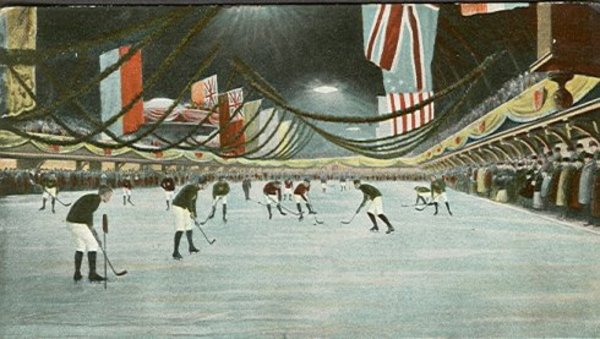- Sports
- Sports before 1800
- Promotion of Sport and Physical Education
- The Amateur Ideal and Professional Sports
- Sports Journalism
- Sports Betting
- Women in Sports
- Violence in Sports
- Sports and Canadian Nationalism
- Creation and Donation of Trophies
- Hockey — The Sport
- Hockey — The Protagonists
- Other Winter Sports
- Summer and Indoor Sports
- Combat Sports
- Water Sports
- Equestrian and Motor Sports
- Recreational Hunting and Fishing
- The Olympic Games
Hockey — The Sport

Source: Link
James George Aylwin CREIGHTON, an engineer and lawyer born in Nova Scotia, is considered one of the founding fathers of hockey:
“Throughout his engineering and legal career, Creighton pursued his love of sports, which he had first developed during his boyhood in Halifax, where a freewheeling, stick-ball game called ‘ricket’ or occasionally ‘hockey’ was played on ice. In Montreal, Henry Joseph, a teammate, later credited him with organizing the first public exhibition of ice hockey at the Victoria Skating Rink on 3 March 1875, played by two teams drawn from the club, where Creighton also served as a judge of figure skating. His nine-man team won two ‘games’ (goals) to one over the opposition led by Charles Torrance. ‘It was this exhibition which aroused city-wide interest and gave rise to the formation of other ice hockey teams and to the rapid development of the game,’ McGill’s physical education director Emanuel M. Orlick would write in the Gazette in 1943….
“… Authors Sydney Francis Wise and Douglas Mason Fisher have classed him with the founders of organized lacrosse and basketball, William George
Arthur FARRELL and his Montreal Shamrocks team-mates transformed the way hockey was played and won the Stanley Cup several times:
“The Shamrocks introduced a major innovation into hockey: the passing game. Team captain Harry Trihey took the lead as rover linking the forwards and the defencemen. With forward passing of the puck not allowed, the favourite tactic was to have one of the forwards advance, with the other three following. As in rugby, the lead would pass back to one of the others when his way was blocked. The Shamrocks speeded up the game by using all four forwards together and passing the puck backwards and sideways to force the opposing defencemen to move.
“Having finished the 1899 season in first place, the Shamrocks took the Stanley Cup [see Frederick Arthur Stanley] away from the defending champions, the Montreal Victorias. They then had to hold it against challengers.”
Maurice (The Rocket) RICHARD started his career in the National Hockey League in 1942, when the league was making changes in its structure and the rules of the game:
“In September [1942], a few days before his marriage to Lucille Norchet, [Richard] signed his first professional contract with the Montreal Canadiens (known in English Canada as the Habs, for Habitants). At the time he began his initial season in the [National Hockey League], the league had just undergone two important changes. Between 1926 and 1931 it had ten teams. The depression, followed by World War II, forced four to withdraw. These were: in 1931 the Pittsburgh Pirates of Pennsylvania (founded in Philadelphia as the Quakers for the 1930–31 season); in 1935 the Ottawa Senators (founded in St Louis, Mo., as the Eagles for the 1934–35 season); in 1938 the Montreal Maroons; and in 1942 the New York Americans (called the Brooklyn Americans during the 1941–42 season). For 25 consecutive seasons there would be only six teams: the Chicago Blackhawks (incorrectly written as two words, Black Hawks, until 1986), the Boston Bruins, the Montreal Canadiens, the Toronto Maple Leafs, the New York Rangers, and the Detroit Red Wings. Many experts think that the addition of a red line at centre ice, in 1942–43, marked the beginning of modern professional hockey. Since 1919–20 there had been two blue lines, and forward passes had been permitted within each zone, but in order to move the puck across the blue line a player had to have possession of it. With the addition of the red line, passing was permitted from behind the net and across the blue line, as far as centre ice.”
The biographies in the following lists provide more information about the beginnings of hockey, the development of organized hockey, and changes made to the rules, strategies, and styles of playing the game:





